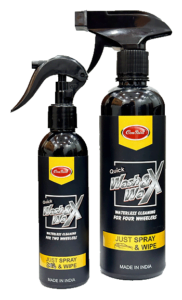Use Com-Paint’s Powerful Powder Coating Defects Solution for Flawless Touch-up Results
Powder coating is a free flowing dry powder application under strong electrostatic forces that binds the paint molecules to the metal substrate giving the paint a much harder finish than conventional liquid painting methods. The process of powder coating is finalized with a curing under proper heat conditions that ensures its longevity and sheen.
Powder coating has a wide variety of applications ranging from electrical equipment, aluminium doorframes, railings, light poles, numerous machines parts, outdoor furniture and just about any metal surface. The Powder coating technique is not a preferred method to paint car bodies as it tends to be heavy and expensive. But it can be used on engine parts, undercarriage and suspension components.
Powder coating brings tremendous durability, strength and anti-corrosive properties to its applications. However, the powder coating method has a lot of factors that can and do go wrong on many occasions. These factors could range from:
- Mechanical:
- Failure of one or more of the machine parts
- Jamming of the air pressure nozzle
- Power delivery being too high or low
- Unsatisfactory cleaning of the parts
- Incorrect spray placement
- Chemical:
- Pigment inconsistencies in the powder composition,
- Powder contamination
- Wrong powder mixture
- Wrong pre-treatment of the surface
- Electrical:
- Earthing issues,
- Sudden drop of voltage
In many cases, certain small areas of the metal item being powder coated are missed out as they are covered by the clip or hanger holding them in place.
Thankfully, all of these problems can be mitigated with paint touch-up sprays like the ones available with Com-Paint. Their Super Acrylic or Acrylic Base Paints can be a one stop shop for all of your touch up needs.
This basically means that you need not send your powder coated panels back to the vendor or for rework for another round of powder coating as you have the perfect powder coating defects solutions at hand.
Com-Paint as a powder coating defects solutions will ensure that the area you touch up blends in with the rest of the metal body and appear to be a part of the original powder coating job.
One should make sure that the area that you want to touch up is clean of any dirt and debris. A 400/600-grit sandpaper should be used to remove anything stuck to the surface followed by a thorough cleaning of the surface, prior to applying the touch-up paint.
Also, before starting to paint, it is necessary to shake the paint can thoroughly to make sure that the paint is mixed in a consistent manner. Paint now should be applied in a series of evenly applied coats to bring it to a uniform finish.










